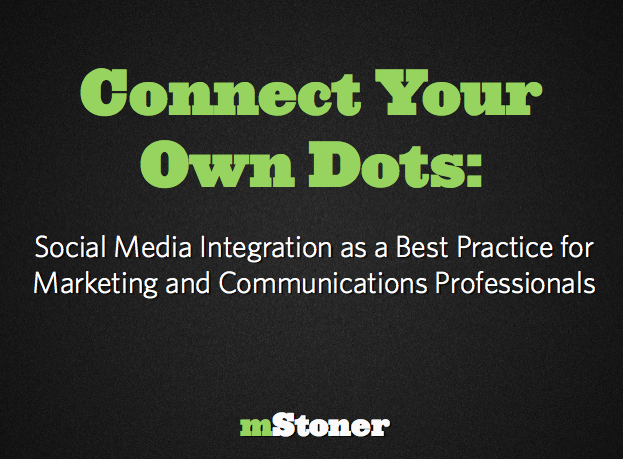Last week, during two webinar presentations of Connect Your Own Dots, more than 132 of us mused about social media integration and best practices. There was some lively back-channel conversation on #connectSMdots and I also promised some follow-up items for webinar attendees. So, here goes…
BACKGROUND ON THE WEBINAR AND THE SLIDE DECK
We know that audiences experience institutional brand through an ever growing list of social media channels; but you can’t expect your audiences to connect the dots. Instead, you need to develop an institutional plan that will allow you to stay on message across multiple digital channels like social media aggregators, websites, content hubs and social media campaigns. Not to mention that when social media is isolated from your broader communication/marketing strategy it’s a risk. The webinar included specific suggestions and demonstrated best practices through case studies from several educational institutions.
For your reference, here’s my slide deck for the webinar via SlideShare.
QUESTIONS WE DIDN’T GET TO DURING THE WEBINAR
Can you talk about the merge, mashup and convergence of mobile/social/digital interaction? Meaning that the tools and the strategy are reliant on one another.
A few months back, I wrote Mobile + Social = Social + Mobile. A read of that post offers more of my thinking on this topic. To be effective during the convergence of mobile and social, the key thing to focus on is content strategy. We know that social apps are hugely popular on mobile devices. When your audience is using an app developed for Facebook or Twitter, for example, your focus does not need to be on the design or the technology. Instead, you can turn your attention to the content that you’re producing. So as you are creating content for social, here are just a few ideas that take into account that, with increasing regularity, this social content will be delivered via small screens:
- Make it visual.
Use photography, graphics and other visual elements; these are always popular on social and they can quickly convey a brand message.
- Make it fun.
Your audience is likely standing in line at the grocery store or waiting for the movie to start while using social on a smartphone. Use whit, humor, storytelling, and even the quirky and unexpected to connect with them.
- Whenever you can, send them to mobile-friendly content.
Social content is typically filled with links back to your .edu website and that’s good. Remember that there will be some frustration if I you get my attention on social while I’m on my mobile phone, but then you send me to content that isn’t mobile-friendly.
Should different platforms (i.e. Facebook, Twitter, Instagram, Pinterest, etc.) be used to communicate different aspects of an overall social media campaign?
Absolutely. The point of integrating various platforms is that your channels become mutually reinforcing. So, your marketing campaign on social might use Twitter for announcements and insider information, or Facebook for a topical timeline, or Pinterest for a photo contest. The idea is that all of the channels are featuring content that is on message and creating the buzz, actions, or egagement that you’re trying to achieve. (In case you missed the webinar, a social media campaign is a focused effort to achieve goals using a variety of channels appropriate to the results sought. (Oregon State University’s Powered by Orange is a brilliant example of a higher ed social media campaign.)
If your background is not in marketing/media, what is the best way to try to teach yourself and learn more if you’re managing social media as your job responsibility?
This is a very important question. In some ways, there’s never been a better time to be a professional communicator. However, we all need to stay current and I’m glad you’re thinking about this as it relates to social. I have two recommendations for you:
- Use social media and other online communities to increase your knowledge. Twitter, in particular, is a super professional development tool. When you follow skilled social media strategists and thought leaders in higher ed marketing, they’ll be sharing links and information that will be useful. EDUniverse and Higher Ed Live are two communities that are chock full of suggestions and best practices related to social media. Participate in those communities and get the most from what your peers have to offer.
- Personal use of social media is also an effective mode for learning more. And, the experimentation that you do on your personal channels is both rehearsal and test-driving for things you might try on your institutional channels. My favorite post on this topic comes from Todd Sanders. Todd is a thoughtful advocate about an approach that relies on personal use of a tool first. He writes, “My number one social web rule is to play with ‘the tool’ through a personal account before using it on a university account.”
Changes to Twitter’s API are coming in 2013. How might these changes affect those relying on Twitter RSS feeds on their website? See this related article from mashable.com.
Although Twitter will end support for RSS, and the new API will become mandatory on March 5, 2013, “More tweets across the web” describes the option to “…to embed interactive timelines of Tweets on any website.” So the short answer to this question is, yes, relying on RSS from Twitter as the integration tool for social and websites will be problematic. What we can learn from all of this is that the API of any social platform is likely to change regularly and must be regularly on the radar of higher ed web developers. In the best of circumstances, enhanced API leads to enhanced social media integration.
